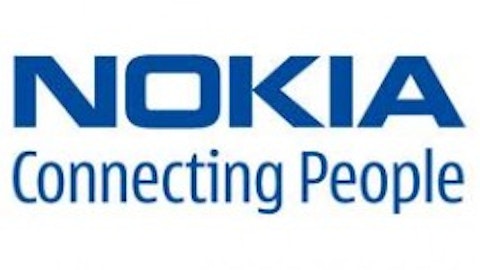eBay’s CEO is John Donahoe, who owns about 400,000 shares as well as 2.8 million options that expire in May. Donahoe has been CEO for about five years and earns just under $1 million in base salary. When you add in a $2.8 million bonus and millions of dollars more in stock grants, his total compensation comes out to $29.7 million.
If that makes you cringe, know that 70% of his total compensation is tied to his performance (and since the company did well last year his pay is somewhat higher than usual).
I find that his huge paycheck is reasonable because if the company starts to decline, so will his bonus, and I am perfectly fine with that. Shares outstanding have been consistent at 1.3 billion, and while the company hasn’t repurchased any shares, it also hasn’t been diluting shareholders’ positions.
Financial analysis
To recap before heading into the numbers, eBay Inc (NASDAQ:EBAY) has a wide moat with many growth opportunities and has a management team that is heavily invested in the success of the company. As a result, I believe that eBay can be a great investment. Let’s look at the numbers to see just how awesome eBay is.
Since 2008, eBay’s sales have increased 64% and net income has increased by 46%.
The cost of goods sold has stayed the same at around 30% of sales. This means that costs aren’t increasing but they’re not decreasing, either, so eBay can’t squeeze profits by cutting costs. It will have to rely on selling more instead of cutting costs.
Net margins have approximately been in the mid-20% range for the past couple of years, which is more than double the industry average.
Return on invested capital is around 14% for the past five years
Equity (or book value) has been increasing around 16% for the past five years
Cash flow from operations has been increasing every year, with a 7% increase from four years ago and a 17% increase from last year.
Free cash flow has also been increasing, growing 3% from four years ago to 12% last year.
Free cash flow/sales decreased 22% four years ago and fell 18% last year. With such a high FCF/sales rate, however, the decline shouldn’t cause investors to shy away. If eBay was reporting 5% FCF/sales and it was decreasing, then I’d start to get nervous. But with 20% of every dollar turning into free cash, I’m content with that.
The return on equity averages to 16% for the past five years, about 3% above the industry average.
Return on assets averages to 11% for the past five years, meaning for every dollar of assets eBay returns 11% on average as net income.
eBay has $4.1 billion in long-term debt, which can be paid off using free cash flow in two years (if it had to). eBay’s debt-to-equity ratio is 0.2, which is reasonable. Although I like companies that have very little or no debt, eBay does a responsible job of managing its debt, and can pay it off if it had to.
All of those metrics are great. Management must be doing something right to produce those stellar numbers. I’m really excited about eBay and it seems to be a great company to own, but only at the right price.
Competition with Amazon.com, Inc. (NASDAQ:AMZN)
Amazon has increased its sales by over 200% since 2008, which is a far better showing than eBay Inc (NASDAQ:EBAY). However, Amazon’s cost of goods sold (COGS) is at a staggering 80%, meaning that for every dollar Amazon makes, it must spend $0.80.
This results in a negative net income for Amazon, not something that’s attractive when investing in a company. Investors are betting that eventually Amazon will turn positive and reward shareholders, but so far Amazon hasn’t done that. Even though the company is doing many great things, I’d stay away from the stock until Amazon increases shareholder value.
Competition with Wal-Mart Stores, Inc. (NYSE:WMT)
Since 2008, Wal-Mart has increased sales by 17% and net income by 28%. In 2012, 75% of sales went to COGS, and net margins came to 4%. For every dollar Wal-Mart made, only $0.04 became profit.
There is growth at Wal-Mart, but it’s much slower than eBay Inc (NASDAQ:EBAY)’s growth. Wal-Mart still has huge COGS and it has stayed at 75% for the past five years, meaning that the company isn’t cutting costs.
Wal-Mart is a good long-term dividend paying stock, and a safe buy for long-term investors. However, there seems to be greater growth opportunities in eBay than with Wal-Mart.
Valuation
Using all these numbers as a guide, I’ll estimate that eBay Inc (NASDAQ:EBAY) will grow around 15% for the next five years. Using the current EPS of $1.99 and the average PE of 16 over the last five years as the baseline, in five years eBay’s stock price should be around $64.




